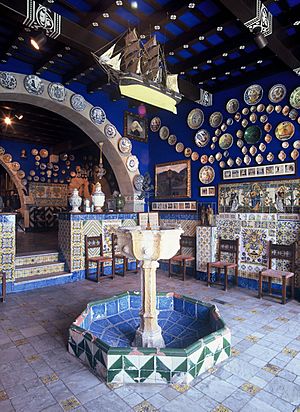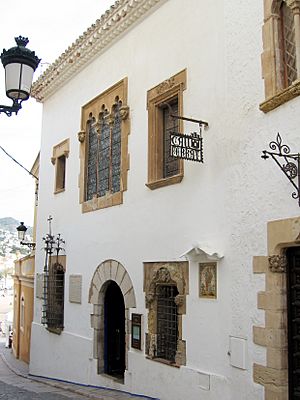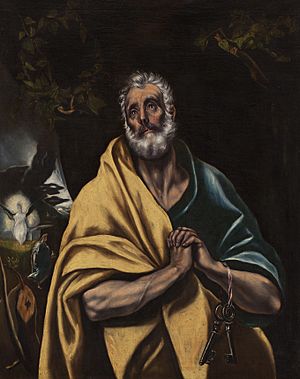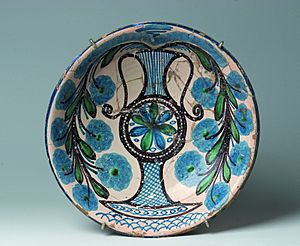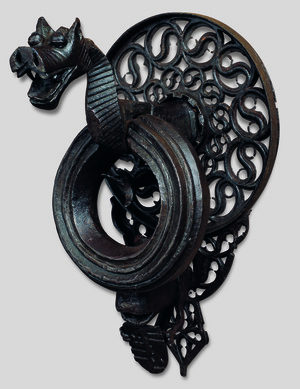Cau Ferrat Museum facts for kids
Cau Ferrat is a famous house and museum in Sitges, a town by the sea. It used to be the home and art studio of Santiago Rusiñol, a very important artist and writer from Catalonia. He was a key figure in a special art movement called Modernisme. Cau Ferrat is one of three museums in Sitges located right on Sant Sebastià beach.
Contents
A Home for Art: The Story of Cau Ferrat
Santiago Rusiñol i Prats was born in Barcelona in 1861. His family wanted him to work in their cotton business, but Santiago chose a different path. He became a painter, writer, collector, and journalist. He saw art as something very special, almost like a religion. He believed artists were chosen to live for their ideals.
Rusiñol used Sitges to share his ideas about "Total Art," where art was like a new religion. He organized special events called the Festes Modernistes from 1892 to 1899. He also built Cau Ferrat between 1893 and 1894. In 1898, he helped open a monument to a famous painter named El Greco. All these things made Sitges a very important place for the Modernisme movement. Rusiñol became a leader in this movement, which aimed to change society through culture and art.
Rusiñol first came to Sitges in October 1891 and stayed for a few months. He liked it so much that he kept coming back often. In the spring of 1893, he decided to buy a small fisherman's house right by the sea. The house had a unique history: its last owner had left it to "Our Lord God" in her will. This meant the money from the house was supposed to pay for prayers for her and her family. Because of this, Rusiñol had to get special permission from the church to buy it. The sale was finally completed on July 30, 1893.
Rusiñol paid 1000 pesetas for the house. He then spent another 2000 pesetas to have it torn down. He wanted to build a new place that would be both his home and his art studio. He hired an architect named Francesc Rogent to design it. The new building even included large Gothic windows from Sitges's old castle, which had recently been taken down. Rusiñol's new home and studio opened a few months later. He named it Cau Ferrat, which was the same name as his old studio in Barcelona that he shared with his friend Enric Clarasó.
Soon, Rusiñol realized he needed more space. In May 1894, he bought the house next door. This allowed him to complete Cau Ferrat as we see it today. That September, he moved his large collection of wrought iron from Barcelona to Sitges. On November 4, during the third Festa Modernista, there was a much bigger opening party. This was because Rusiñol timed it with the arrival of two paintings by El Greco that he had bought in Paris.
Rusiñol spent a lot of time at Cau Ferrat between 1894 and 1899. His main goal wasn't just to live there comfortably. He wanted to create his own special art collection. Because of this, Cau Ferrat became a popular meeting place for artists and thinkers of that time. Many famous people visited, including writers like Joan Maragall and Emilia Pardo Bazán, and musicians like Enrique Granados and Manuel de Falla.
When Rusiñol passed away, he left Cau Ferrat and all its collections to the town of Sitges. He wanted it to become a public museum. The museum officially opened on April 16, 1933. By leaving Cau Ferrat to the people of Sitges, Rusiñol completed his dream. He had always wanted to share the beauty he found in Sitges through his art.
Every item you see in Cau Ferrat tells a part of Santiago Rusiñol's life and art. It's more than just a regular museum. It gives you a glimpse into the mind of a great artist.
What You Can See: The Collections
Paintings and Drawings
The collection of paintings and drawings at Cau Ferrat is one of its biggest treasures. It includes many works by Rusiñol himself. These were the pieces he loved most and kept throughout his life. You'll also find art by other important Catalan artists from the late 1800s and early 1900s. These include Ramon Casas, Pablo Picasso, and Isidre Nonell. Many of them were Rusiñol's friends. The paintings and drawings show Rusiñol's personal taste. They also reflect the popular art styles of his time, like Impressionism and Symbolism.
As you walk through the museum, you'll see art in different rooms. These include the Entrance Hall, Kitchen/Dining-Room, Sala del Brollador (Fountain room), Office, Living-Room, and the Great Hall.
Ironwork
Santiago Rusiñol was famous for collecting ironwork even before he became well-known as a painter or writer. Thanks to him and a few other collectors, wrought iron art became more respected. It was no longer seen as a less important craft. Instead, people started to study it seriously. This also led to ironwork being used a lot in Modernista buildings. You can see examples in the designs of famous architects like Gaudí.
Glassware
Rusiñol's collection of glass arrived in Sitges after Cau Ferrat was built. It's made up of almost 400 items that Rusiñol bought at different times. In the Great Hall, you'll find glass from more modern times. The Sala del Brollador displays older, archaeological glass. Because the items come from different places and times, you can see many different ways glass has been made throughout history.
Furniture and Sculpture
When you first enter Cau Ferrat, you might notice how many items are packed into the museum. It can feel like there's art everywhere! Because of this, some things might be missed, like the furniture and sculptures. These pieces are often seen as just decorations. However, they are important parts of the collection too.
Ceramics
Santiago Rusiñol also collected a lot of ceramics. Most of this collection is found in two rooms on the ground floor: the Kitchen/Dining-room and the Sala del Brollador. Here, you can see over 200 different ceramic items. They range from the 1300s to the 1800s. You'll find plates, bowls, jars, and even tiled panels.
These ceramic pieces come from many different places. About a quarter of the collection is from Catalan potteries. But you'll also see items from other parts of Spain, like Valencia and Aragon. There are even a few pieces from Majorca, Italy, and Florence.
See also
 In Spanish: Museo Cau Ferrat para niños
In Spanish: Museo Cau Ferrat para niños
- Maricel Museum
- Can Llopis Romanticism Museum
- Santiago Rusiñol


